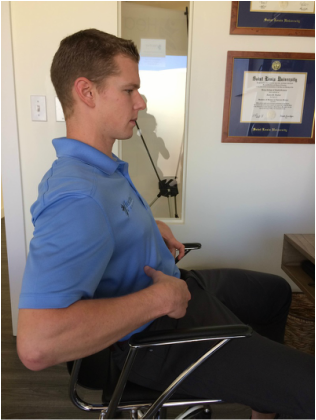|
We have all heard about the negative effects of prolonged sitting. In fact, some people argue that sitting is the new smoking. Unfortunately, chairs are not going anywhere, so we need to make sure we are sitting in a healthy position for our spines! In this post, I will discuss how to sit in a healthy posture to minimize the negative effects of the chair. Sitting decreases metabolism, increases one's risk of blood clots or pulmonary emboli, & places extra stress on muscles and joints.Since the hip bones are the only fixed point grounded to the chair, a good sitting posture should begin with the hips and pelvis in a neutral spine position. To find a neutral pelvis, first identify both of your sit bones. Next, slightly roll the pressure onto the front portion of the bones. This action should tilt the hips forward, creating a small curve in the low back. It is important to only be slightly forward on the hip bones. A common sitting misalignment is excessively rocking the pelvis forward (seen in left picture below), which forces the low back to arch excessively. Those who have a tendency to over arch their low back will feel added tension or spasms as they attempt to sit upright. Next, draw in the lower abdominals by bringing the belly button toward the spine. This action corsets the lower back and provides stability to the spine. Finally, it is important to lengthen through the middle portion of the spine. In the clinic, I have found the best cues to be "open up through the upper chest," and "imagine someone is pulling a string connected to the front of your shirt collar up toward the ceiling." When performing this action, the shoulders will naturally fall into a proper posture. It is not necessary to draw your shoulder blades back. After the chest is upright, refocus the attention to the neck by giving a small chin nod. The chin tuck prevents stiffness in the upper back and can reverse the 'hump back' posture that is commonly seen in older individuals. Maintaining this perfect sitting posture is difficult. Often times, we find ourselves slowly slipping back into the old, comfortable habit. While this is not ideal, it is inevitable. To decrease this from occurring, I recommend placing a small towel or pillow in the fold of the low back. The pillow will help maintain the natural curve of the spine and keep the pelvis from tilting backward. Top 3 Seated Postural CuesWhile having a good seated posture is important, the most beneficial thing someone can do is simply stand up! As I have mentioned in a previous post on posture, "the best posture is one that requires regular movement." At Heafner Health, I recommend standing every 15-20 minutes and performing basic corrective exercises every 2 hours.
-Jim Heafner PT, DPT, OCS
3 Comments
|
Heafner HealthPhysical Therapy Archives
April 2024
Categories |








 RSS Feed
RSS Feed
